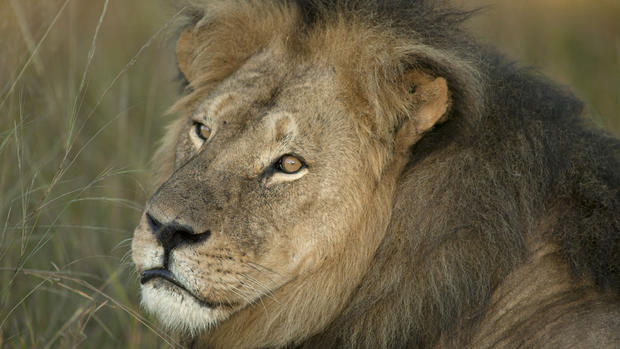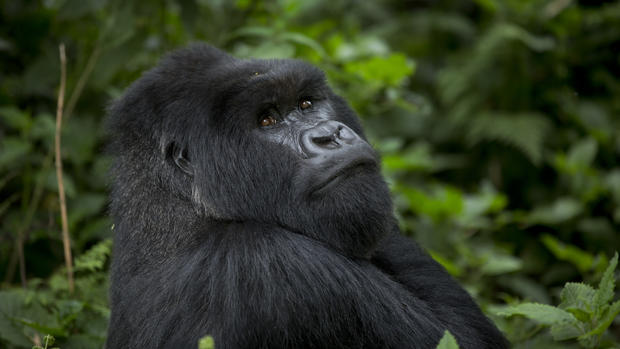After Harambe's death, gorilla activists point to "bigger picture"
The death of Harambe, the endangered silverback gorilla shot at the Cincinnati Zoo after a child got into its enclosure, has provoked an outpouring of raw emotion -- from outrage to sadness -- on social media. But what happens next? Could this emotion be harnessed in productive ways to support urgent gorilla conservation efforts around the world?
In interviews, leading gorilla conservationists were optimistic, but cautiously so.
"People do have a tendency to get engaged in these kinds of stories, but it's important to put the story in context and look at the bigger picture," said Craig Sholley, vice president for philanthropy and marketing at the African Wildlife Foundation. "We could end up in a world without gorillas. I would challenge people to use this tragic example and apply it at a grander scale and work to ensure we have wildlife in wild lands in the future."
In the past, certain viral stories have led to greater public engagement in conservation. Last year, after a Minnesota dentist gained worldwide notoriety for killing a beloved Zimbabwean lion named Cecil, the African Wildlife Foundation noticed a spike in donations, Sholley said.
"It gave us an opportunity to tell the real story of what was happening in Africa from a lion population standpoint," he said. "In the best of all worlds, this tragic story will translate into our abilities in Africa."
Aside from those in captivity, gorillas live on only one continent in the world: Africa. There, lowland gorillas like Harambe face serious threats from multiple directions. Habitat loss, particularly tied to the timber and extraction industries, is a major issue. Hunting is another problem, as gorilla bushmeat is considered a delicacy in several Western African cultures. Certain contagious diseases, like Ebola, have also hit these populations particularly hard.
Then there is the problem of illegal poaching, with disreputable dealers specifically preying on baby gorillas for black market trafficking.
Frank Keesling, president of the Mountain Gorilla Conservation Fund, said that despite the outpouring of emotion for Harambe he has not seen any significant uptick in public engagement in his organization's work. However, he has fielded multiple calls from individuals curious to hear what he thinks should have happened at the Cincinnati Zoo. Keesling said he sees it as an opportunity to educate new audiences about the incredible humanity of endangered gorillas.
"Everyone we've spoken to has been enlightened about the behaviors of these animals. They're listed as the gentle giants. They're as gentle as they can possibly be, given that they're 400 to 600 pounds and very strong," he said.
Keesling hopes the interest in Harambe will naturally morph into increased engagement in conservation.
"We're not trying to capitalize on a tragedy. But we will focus our efforts and energies on the animals in the wild," he said.
Keesling's organization -- founded by his mother Ruth, who worked closely alongside the famed conservationist Dian Fossey -- has focused on mountain gorillas since it began in 1985. Around that time, there were only 248 known mountain gorillas in the wild. Now, there are 880. It's a population Keesling speaks passionately about.
"Once you look into the eyes of a mountain gorilla, you are forever changed," he said.
Some organizations have reported an increase in donations since the Cincinnati Zoo incident. Sonya Kahlenberg, executive director of the Gorilla Rehabilitation and Conservation Education (GRACE) Center in the Democratic Republic of Congo, said her organization has noticed a spike in small individual donations since Harambe's death, which has garnered media attention not just in the U.S. but around the world.
"We need all hands on deck right now, and increased public awareness about the conservation crisis wild gorillas are facing can be one positive outcome from this tragedy," Kahlenberg said in a statement sent via email from the D.R.C.
Kahlenberg's group specifically works with Grauer's gorillas, a little known subspecies that has declined by nearly 80 percent in the past two decades due to poaching and political unrest in the D.R.C. The organization rehabilitates gorillas who have been orphaned by poaching with the goal of returning them to the wild. Today, there are fewer than 4,000 wild Grauer's gorillas left.
Other institutions are trying to make the connection between Harambe and the struggling gorilla population worldwide. One of those institutions is the Gladys Porter Zoo in Brownsville, Texas, where Harambe was born and spent most of his life until age 15, when he was transferred to the Cincinnati Zoo in hopes that he would breed with one of the zoo's female gorillas.
On Monday, the Gladys Porter Zoo set up a fund in Harambe's name to raise money for the Mbeli Bai Study, a conservation research initiative on Western lowland gorillas based in the Republic of Congo.
"We want something positive to come out of it. His name means 'to come together,' and it's also a rallying cry. In his memory, we'd like people to come together and support his cousins in the wild," said Cynthia Galvan, the zoo's director of marketing.
As of close of business on Wednesday, the zoo had raised $4,298 for the conservation initiative.
In this particular situation, there's a perceptible gap between the public's high levels of emotion and low levels of conservation knowledge, Galvan said.
"There are a lot of people who are outraged and upset and don't necessarily know the plight of the gorillas in the wild or the plight of many animals in the wild," she said.
For individuals thinking for the first time about how they can help gorillas survive, Keesling has some advice.
"If you really want to make a difference in the animal kingdom, pick a focus and stay with that focus if you want to make the biggest impact possible," he said. "You can't save all animals. You can't save the world. If you pick a focus, you stick to it, and you really work hard at it, you can make a difference."


